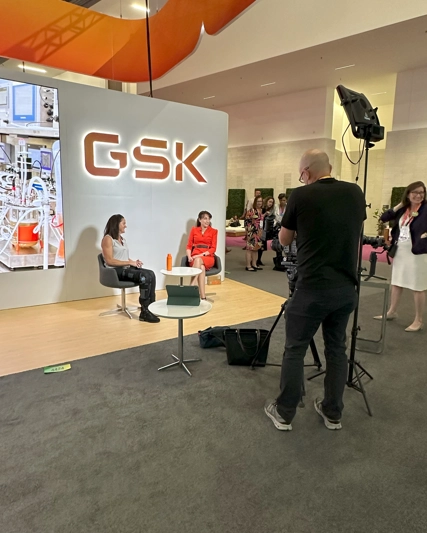Issued: Philadelphia, PA
For media and investors only
Brooke Shields Partners with GSK to Educate Adults 50 and Older About Their Shingles Risk
-
Brooke Shields convenes other celebrities, influencers and patient advocates over 50 to discuss the power of aging and how to protect their health
-
Shields directs a short film, encouraging adults 50 years of age and older to talk to their doctor or pharmacist about their risk for shingles — a disease that affects about 1 million people annually in the US — and about vaccination
-
The partnership is part of GSK’s national THRIVE@50+ campaign
Philadelphia, PA — GSK plc (LSE/NYSE: GSK) is partnering with Brooke Shields, as part of its THRIVE@50+ campaign, to encourage people 50 and older to embrace and protect the power they’ve found in aging by asking their doctor or pharmacist about their risk for shingles and about vaccination.
Shields exemplifies what it means to thrive at any age, including now, at her current age of 59. The actress, TV personality, model and entrepreneur now adds fierce health advocate to her resume. Like so many others her age, at a time when Shields was stepping into a new, unapologetic power, she also learned that with age comes the important lesson of protecting one’s health from vulnerabilities like shingles. In fact, 99% of people over the age of 50 are at risk for developing shingles, although not everyone will.1
Brooke Shields said: “For so long, we’ve been conditioned to fear aging, but the reality is that age is power. As I’ve gotten older, my life experiences have really solidified who I am and what I stand for, and when I talked to other women who were a part of this campaign, it’s clear that I’m not the only one who feels this way. The unfair twist is that just as we’ve reached this time of our lives where we feel like the best version of ourselves, we’re also experiencing new health risks. When I learned that people over 50 are at an increased risk for shingles, I couldn’t help myself from starting the conversation. This matters because our power is worth protecting.”
Part of Shields’ partnership with GSK’s THRIVE@50+ campaign involved her directing and producing videos with other influential women who are thriving in their 50s and beyond, including football mom Donna Kelce, actress Gina Torres, reality TV star Susan Noles and former shingles patients, among others, each sharing their own unique stories and radiating the power they’ve come into with age. World-renowned fashion and lifestyle photographer Pamela Hanson joined the group to capture that power in her iconic portrait style.
Leah Smith, PharmD, GSK medical educator, said: “Shingles can be an isolating experience that can also really take a toll on one’s quality of life. And it’s not as uncommon as you might think — every year, there are about one million cases of shingles in the US alone. Age is the most important risk factor for shingles, so anyone over 50 should consider asking their doctor or pharmacist about shingles and about vaccination.”
GSK’s goal with their THRIVE@50+ campaign is to create a cultural movement around healthy aging, grounded in the genuine and authentic experiences that bring the community together.
About THRIVE@50+
THRIVE@50+ is a national public health initiative from GSK to educate people 50 and older about their risk for shingles, due to the natural aging of the immune system, and the impact the disease can have on everyday life. We encourage people 50 and older to understand how they can help prevent shingles, like asking their doctor or pharmacist about their risk of shingles and about vaccination, so they can stay ahead of this health challenge and continue to thrive.
About shingles
Shingles is caused by the reactivation of the varicella-zoster virus (VZV), the same virus that causes chickenpox.1 By age 50, VZV is present in most adults2 and may reactivate with advancing age.3 As people age, the strength of the immune system’s response to infection wanes, increasing the risk of developing shingles.1
Shingles typically presents as a rash, with painful blisters across the chest, abdomen or face.3 The pain is often described as aching, burning, stabbing or shock-like.4
Following the rash, a person may experience post-herpetic neuralgia (PHN), a long-lasting nerve pain that can last weeks or months and occasionally persists for several years.4 PHN is the most common complication of shingles, occurring in 5–30% of all shingles cases, from findings in various studies.5
About GSK
GSK is a global biopharma company with a purpose to unite science, technology, and talent to get ahead of disease together. Find out more at gsk.com.
Cautionary statement regarding forward-looking statements
GSK cautions investors that any forward-looking statements or projections made by GSK, including those made in this announcement, are subject to risks and uncertainties that may cause actual results to differ materially from those projected. Such factors include, but are not limited to, those described under Item 3.D “Risk factors” in GSK’s Annual Report on Form 20-F for 2023, and GSK’s Q2 Results for 2024.
References
CDC. Shingles (Herpes Zoster): Clinical Overview. Available at: https://www.cdc.gov/shingles/hcp/clinical-overview/
Johnson RW, et al. Herpes zoster epidemiology, management, and disease and economic burden in Europe: a multidisciplinary perspective. Ther Adv Vaccines. 2015;3(4):109-120.
Mueller NH, et al. Varicella zoster virus infection: clinical features, molecular pathogenesis of disease and latency. Neurologic Clinics. 2008;26;675-697.
Cheng J, Rosenquist RW. Herpes zoster and postherpetic neuralgia. Fundamentals of Pain Medicine. 2018:221-5.
Kawai K, Gebremeskel BG, Acosta CJ. Systematic review of incidence and complications of herpes zoster: towards a global perspective. BMJ Open. 2014;4:e004833. doi: 10.1136/bmjopen-2014-004833.


